A primordial deity in Greek and Roman mythology, Nyx helped shape the early universe — and commanded respect even among the mightiest gods.
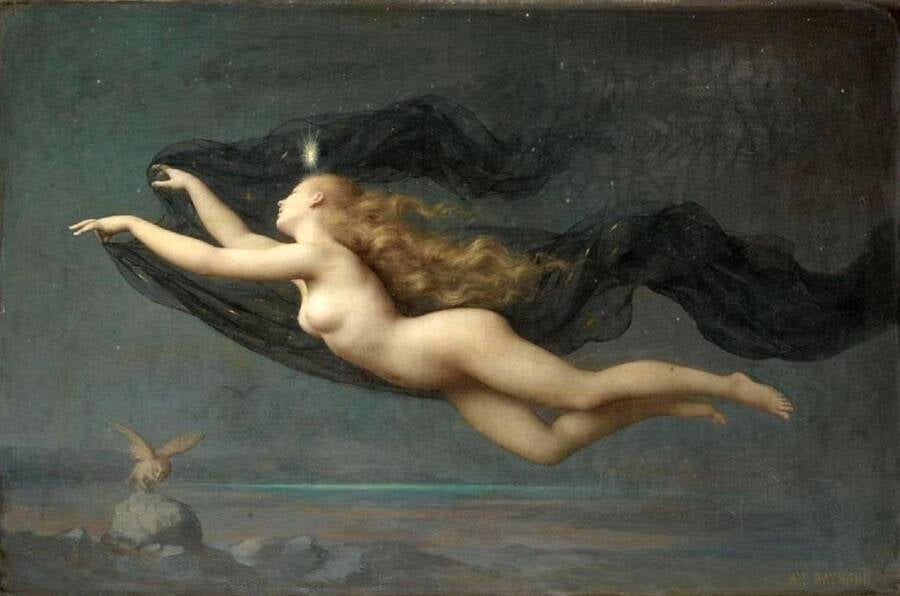
CBW/Alamy Stock PhotoA portrait of the goddess Nyx by Auguste Raynaud.
Famously mentioned in Hesiod’s Theogony in the 8th century B.C.E., Nyx is one of the oldest deities in Greek mythology. The primordial goddess of the night, Nyx gave birth to numerous offspring, who embodied both negative and neutral forces, including sleep, dreams, strife, and death.
Among the Greeks, Nyx was revered for her immense power. Her influence appears in epic poems like Homer’s Iliad, where she intervenes to protect her son Hypnos from Zeus and scares Zeus into submission.
Nyx was said to be cloaked in black, and she was often depicted riding a chariot pulled by horses enveloped in darkness. She was believed to be a beautiful yet shadowy figure, and she was associated with concepts like the balance between light and darkness. The Romans later adopted Nyx under the name Nox, emphasizing her connection to physical darkness and sleep.
Though few ancient depictions of Nyx exist today, she captured the imagination of countless poets and artists throughout the centuries. While she was not as famous as other legendary gods, both the Greeks and Romans acknowledged her role in the creation of the early universe — and her willingness to do whatever it took to protect her children.
The Mythological Family Tree Of Nyx, The Goddess Of The Night
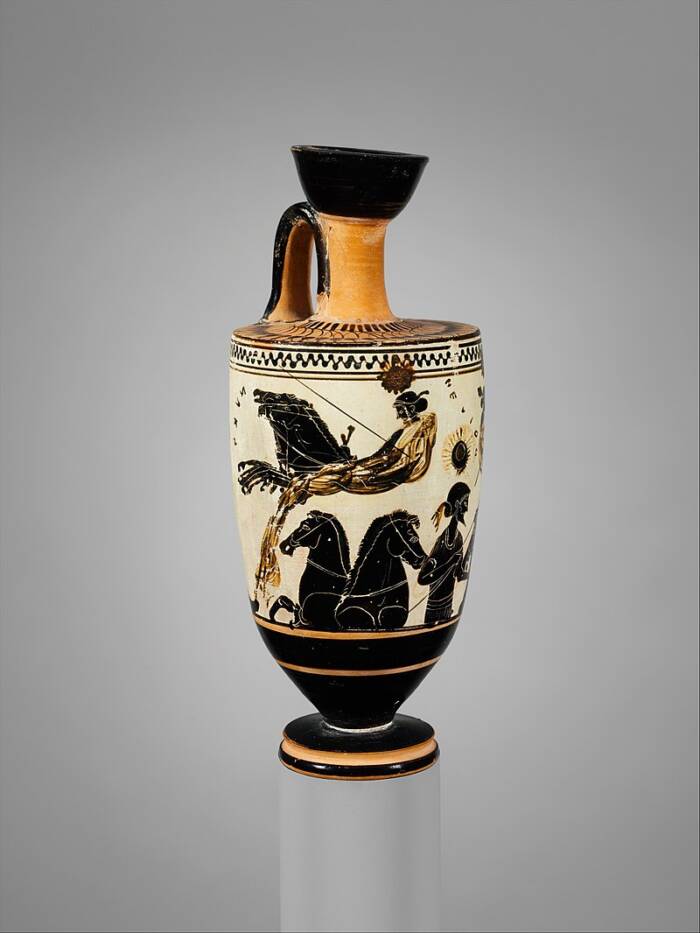
Metropolitan Museum of Art/Wikimedia CommonsA vase depicting Nyx riding in a chariot. Circa 500 B.C.E.
One of the earliest mentions of the goddess Nyx appears in the Greek poet Hesiod’s Theogony. In his poem, which also includes mentions of mythical figures like Medusa, Hesiod describes Nyx as the daughter of Chaos, the “void” that existed before the creation of the universe.
Nyx, the goddess of the night, is described as a primordial deity, meaning she is among the oldest Greek gods and goddesses to exist.
Accounts of Nyx’s family tree vary when it comes to her offspring. But as one of the first deities, Nyx clearly had ample time to reproduce. According to Hesiod, Nyx is the mother of numerous children, some of whom are associated with negative forces such as discord, nightmares, and doom.
However, Hesiod also mentions that some of her children personified neutral or positive qualities, including dreams, light, old age, and sleep.
Greek mythology holds that some of Nyx’s children were born of a “union in love” between Nyx and her brother Erebus. However, she was also able to create some of her children on her own, without a partner.
Eventually, a Greek poet named Bacchylides added to Nyx’s lore, theorizing that she also parented Hecate, the goddess of magic and spells.
Some accounts said that Nyx was the mother of Uranus, the god of the sky, and sometimes even the mother of Gaia, the Earth goddess (though it was more often believed that Gaia emerged from Chaos like Nyx).
Throughout the centuries, Nyx’s family tree was altered several times to include new offspring, consorts, and even parentage. Her story changed with time, but one thing remained the same: Nyx was one powerful goddess.
Greek Mythology’s Most Famous Accounts Of The Goddess Nyx
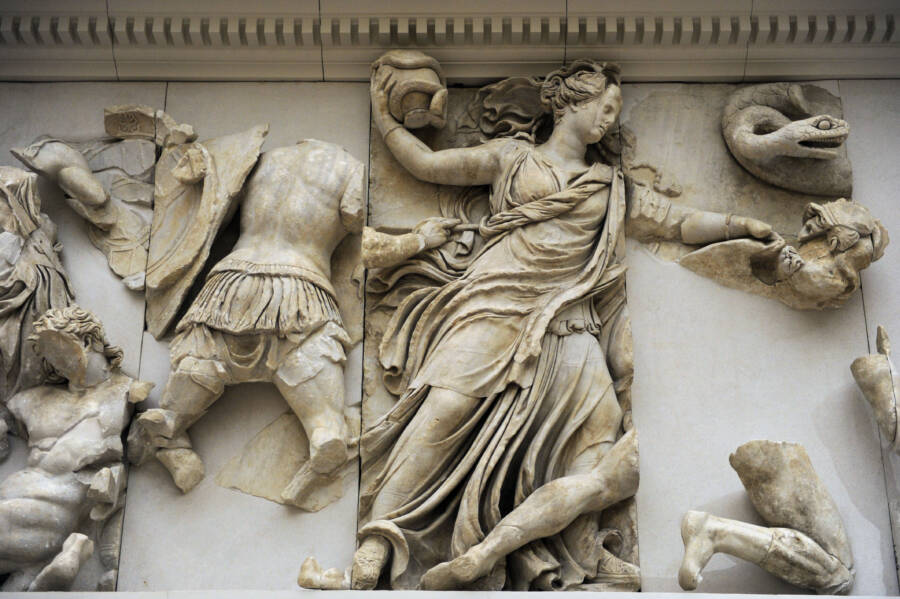
PRISMA ARCHIVO/Alamy Stock PhotoA possible depiction of Nyx holding a vessel wrapped in snakes on the Pergamon Altar.
Other than Hesiod’s famous mention of Nyx, Homer’s Iliad includes one of the best-known references to Nyx and her immense power.
According to Homer’s 8th century B.C.E. poem, Nyx was so powerful that even Zeus, the King of the Gods, feared her. In Iliad, Zeus’ wife Hera asks Hypnos to put Zeus to sleep. Hypnos refuses, saying that he had tried — and failed — to put Zeus to sleep before. This led Zeus to hunt Hypnos down, and Zeus only backed off after Hypnos sought refuge in Nyx’s home.
As Hypnos recalled: “I reached [Nyx] in my flight, and Zeus let be, though he was angry, in awe of doing anything to swift Nyx’s displeasure.” This is especially notable as Zeus was a mighty god and rarely feared other deities.
That said, Nyx’s personal story is explained in greater detail in Theogony. According to this poem, Nyx resides in the underworld. Her home is described as “wrapped in dark clouds.” Despite this gloomy image, her children have often been depicted as living with her throughout antiquity, further contributing to her reputation as a protective, motherly figure.
Meanwhile, Apollonius of Rhodes, the author of the Argonautica, describes Nyx’s lair as such: “Rhone, which flows into the Eridanus, and in the strait where they meet the churning water roars. Now that river, rising from the end of the earth, where the gates and precincts of Night are located.”
In the 5th century B.C.E., more descriptions of Nyx’s physical appearance emerged in written accounts. In Euripides’ play Ion, the playwright describes Nyx as donning a black cloak and riding a chariot pulled by two horses — a detail that would be mentioned by many other sources.
When it came to worshiping Nyx, there is very little evidence to suggest she had a cult that was solely dedicated to her. However, she was revered as an important background figure in a number of different ancient cults. Furthermore, Nyx’s recurring mentions in epic poems and other sources demonstrate that the ancient Greeks held reverence for her in other ways.
Some Greek writers, such as Plutarch and Pausanias, said that oracles once belonged to Nyx and that a statue of her even existed at the Temple of Artemis at Ephesus, one of the Seven Wonders of the Ancient World.
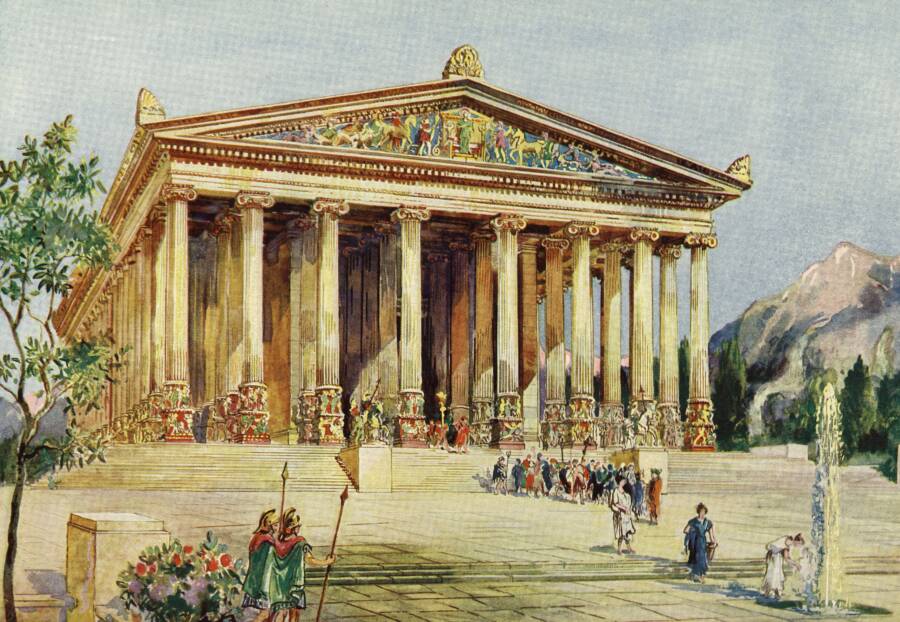
Classic Image/Alamy Stock PhotoAn artistic recreation of the Temple of Artemis, which once purportedly housed a statue of Nyx.
Overall, Greek writers viewed Nyx, the goddess of night, as a powerful being with an essential role in creating the early universe. Although her persona was somewhat dark and her family tree included the likes of deceit, misery, and doom, respecting Nyx came naturally to the ancient Greeks.
How Did The Romans Understand And Worship The Primordial Goddess?
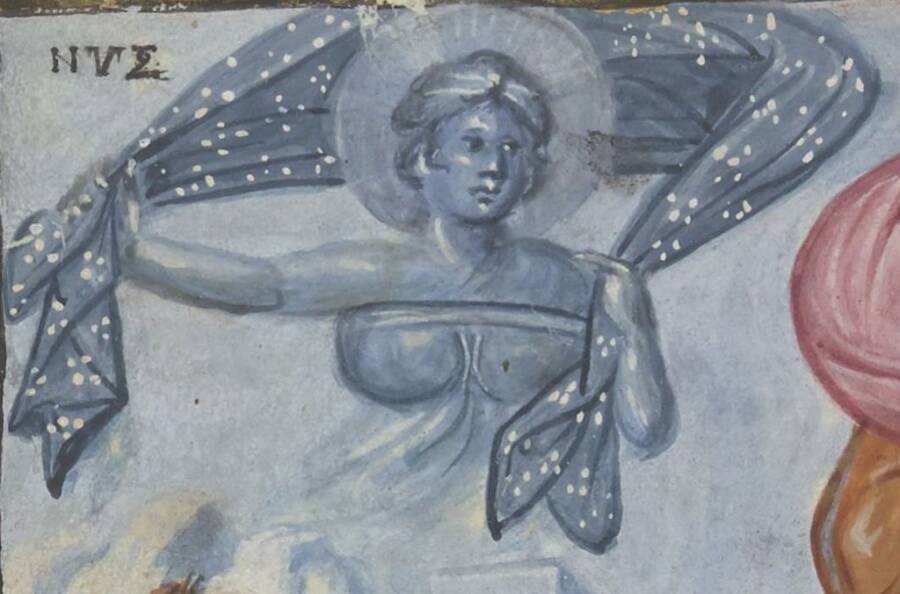
Public DomainA portrayal of Nyx in a 10th-century Greek manuscript.
Nox, the Roman equivalent of Nyx, was a slightly altered version of the goddess that emphasized the darker aspects of her nature.
In the Roman poet Virgil’s 1st century B.C.E. work Aeneid, Nox is described as living in the underworld. Similar to her Greek depictions, the Roman Nox is often seen riding in a chariot in the sky. One interesting addition to her portrayal in Roman mythology was a garland of poppies over her head. These depictions also see her being closely associated with stars and the Moon.
The Romans highlighted her relationship with darkness, writing that her chariot brought nightfall across the Earth, and with it, much-needed sleep to all. Depictions of Nox have been found on Roman sarcophagi, emphasizing her more morbid role in bringing people to eternal sleep.
Like the Greeks, the Romans also pondered her family tree. According to Roman writer Hyginus, Nox is the offspring of Chaos and Caligo, the personification of mist. With her sibling Erebus, Nox produced numerous offspring. In some legends, Nox and Pluto, the god of the underworld and the Roman counterpart to Hades, had children together as well.
The Romans did not appear to celebrate or worship Nox widely. There are some Roman accounts of people in various ancient cults sacrificing dark animals to the goddess of night, such as black roosters, black bulls, and black sheep, but little evidence of organized worship has ever been found.
Overall, both the Greeks and the Romans viewed Nyx, the goddess of the night, as a nuanced and fearsome goddess. She embodied not only the physical aspect of darkness, but also the metaphorical aspects of it. Today, like in antiquity, Nyx reminds us of the enduring balance between light and dark, night and day, that governs the world that we live in.
After reading about Nyx, dive into the story of Persephone, the Greek queen of the underworld. Then, learn about six of the craziest mythological gods.





